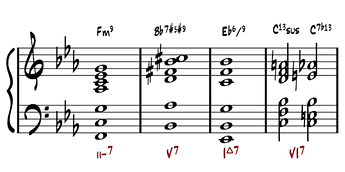Are there any rules of thumb for making intros if a song doesn’t start on the I chord, but for example on the II or VI chord? I’m currently making an intro for the song I Fall In Love Too Easily and its first chord is IIm. If I use for example the 1625 or 143625 formula for composing the intro, do I have to do it in the key of the song or in the key of the first chord? So is the last chord of the intro always the dominant of the first chord of the song?
Hi @MikeS ,
usually we want to have something that resolves nicely to the first chord of the tune;
for example in your situation, I would finish the intro with II V to the IIm, for example in the key of Ebmajor, I would finish the intro with Gm7b5 C7 → Fm7 (beginning of the song).
Here’s a tutorial I made on the subject you can check out:
Hi Mike ![]()
A nice trick to set up the ii-7 chord is to play 251, 16251, or 36251 and then after the I chord, go to back to the VI7 which sets up the ii-7.
Here’s a 251 in Eb Major, which then moves to the VI dominant. I like to play the VI chord as a sus9 or sus 13, to altered dominant movement, as in this example:
Starting on the #4
Here’s a longer variation that starts on the #iv-7b5 and leads all the way to the I chord via 25s and finally the VI7sus to VI7alt to set up the ii-7 chord:
This notation is the lesson below where we dive deeper into the numeric harmony, voicing options, and melodic considerations.
The notation above isn’t designed to be played exactly as written, but instead show some possible ‘landing points’ for the voicings that can be connected with melodic decoration, I show some demonstrations in this lesson:
This introduction would work nicely for your arrangement of “I Fall In Love To Easily” - try that out!
I realised I didn’t really answer your question above.
Whilst there are no ‘set-in-stone’ rules, finishing your intro with the dominant of the first chord will always sound logical and create a convincing resolution into the tune.
The cool thing with diatonic 7th chords is that we can change the chord qualities. A very common one is changing minor7 to dominant7.
You can see this in my comment above where the diatonic vi chord in Eb major would be C-7, but instead we play C7 which then creates that dominant V7-I resolution into the ii-7 chord.
If the tune is in Eb but starts on the ii-7 chord, for me it makes sense to play the intro in Eb so there is some cohesion between the song and the intro, perhaps you could quote the song’s melody or a motif from the melody etc… , and then simply tweak the VI chord from minor to dominant as the last chord of the intro.
That would be my recommendation - check out the lesson I referenced above and it should be a little clearer.
Hi @Hayden and @Tuomo , thank you for your thorough responses. Tuomo, I watched the tutorial you linked. It had some excellent tips that I need to practice and remember for intros. Hayden, I agree that having the intro in the same key makes sense. A sudden key change might surprise the listeners and possibly the soloist. Of course, anything is possible with enough skill and style, but I think it’s best for me to practice a few basic intro formulas and learn to use them. Thanks for the tutorial tip, I’ll watch it right away.

